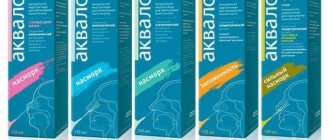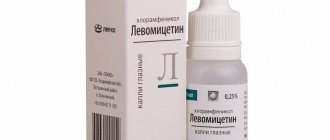Release form and composition
Dosage forms:
- nasal drops 0.01%; 0.025% or 0.05%: transparent colorless or yellowish liquid (5, 10 or 15 ml in polymer dropper bottles, 1 dropper bottle in a cardboard box);
- nasal spray 0.025% or 0.05%: transparent, slightly yellow or colorless liquid (15 ml in polymer bottles equipped with an actuator complete with a protective cap, 1 bottle in a cardboard box).
Each pack also contains instructions for using Rinostop Extra.
1 ml of nasal drops contains:
- active ingredient: oxymetazoline hydrochloride – 0.1; 0.25 or 0.5 mg;
- auxiliary components: citric acid monohydrate, sodium citrate dihydrate, glycerol, benzalkonium chloride 50% solution, purified water.
1 ml of nasal spray contains:
- active ingredient: oxymetazoline hydrochloride – 0.25 or 0.5 mg;
- auxiliary components: glycerol, sodium citrate dihydrate, benzalkonium chloride, citric acid monohydrate, purified water.
Pharmacological properties
Pharmacodynamics
Rinostop Extra is an anticongestive drug for topical use in otorhinolaryngology. Its active substance, oxymetazoline, is an alpha-adrenergic agonist and has a vasoconstrictor effect. Its application to the inflamed nasal mucosa helps eliminate the symptoms of rhinitis, reducing nasal discharge, swelling and congestion. By eliminating swelling of the nasal mucosa, aeration of the paranasal sinuses and middle ear is restored, preventing the development of bacterial complications such as sinusitis, sinusitis or otitis media.
Intranasal use of oxymetazoline in therapeutic concentrations restores nasal breathing and does not cause irritation or hyperemia of the nasal mucosa. The therapeutic effect occurs quickly and lasts up to 12 hours.
Pharmacokinetics
When administered locally intranasally, oxymetazoline does not have a systemic effect. The half-life is 35 hours.
Excreted through the kidneys (2.1%) and intestines (about 1.1%).
Contraindications
Absolute:
- atrophic rhinitis;
- condition after transsphenoidal hypophysectomy;
- angle-closure glaucoma;
- indication in the anamnesis of surgical interventions on the dura mater of the brain;
- hypersensitivity to the components of Rinostop Extra.
Age contraindications:
- drops 0.025% and spray 0.025%: children up to 1 year;
- drops 0.05% and spray 0.05%: children under 6 years of age.
With caution and only after prior consultation with a doctor, drops and spray Rinostop Extra should be used for arterial hypertension, tachycardia, arrhythmia, coronary heart disease, chronic heart failure, chronic renal failure, increased intraocular pressure, pheochromocytoma, hyperthyroidism, diabetes mellitus, clinical manifestations of prostatic hyperplasia glands (urinary retention), porphyria, severe atherosclerosis, during pregnancy and breastfeeding, with concomitant therapy with monoamine oxidase inhibitors (and within 14 days after their discontinuation), tricyclic antidepressants, bromocriptine and other drugs that increase or contribute to an increase in blood pressure (BP) ).
Directions for use and doses
Intranasally.
Spraying is carried out after removing the safety cap from the sprayer. The sprayer is inserted into the nose and, pressing on its base, sprays for 1 second.
For adults and children over 6 years of age (0.1% spray): one spray from a spray bottle into each nasal passage, usually 3-4 sprays per day are sufficient; should not be used more than 3 times a day.
For children aged 2 to 6 years (0.05% spray) one spray from a spray bottle into each nasal passage 1 or 2 times a day; should not be used more than 3 times a day.
Do not use the drug without a break for more than 3-5 days.
Rinostop Extra, instructions for use: method and dosage
Nasal drops
Rinostop Extra drops are used intranasally by inserting into each nasal passage.
The following concentrations of the drug should be used, taking into account the patient’s age:
- adults and children over 6 years of age: drops 0.05%;
- children 1–6 years old: drops 0.025%;
- infants up to 1 year: drops 0.01%.
Recommended dosage:
- patients older than 1 year: 1-2 drops in both nostrils 2-3 times a day;
- children under 1 year: up to four weeks of age - 1 drop, and from the fifth week of life - 1-2 drops in both nostrils; frequency of use – 2–3 times a day.
The duration of treatment without consulting a doctor is 5–7 days.
If after three days of using Rinostop Extra there is no improvement or the symptoms of rhinitis intensify, you should consult a doctor.
Nasal spray
Spray Rinostop Extra is used intranasally by injection into each nasal passage.
Taking into account the patient’s age, the drug should be used in the following concentration:
- adults and children over 6 years of age: spray 0.05%;
- children 1–6 years old: spray 0.025%.
Recommended dosage: 1 spray into both nostrils 2-3 times a day. The duration of treatment without consulting a doctor is 5–7 days. A repeat course can be started after a few days.
If there is no improvement within three days of therapy or an increase in symptoms is observed, you should consult a doctor.
Frequent and prolonged use of Rinostop Extra may cause recurrence or worsening of nasal congestion, in which case the use of drops or spray should be discontinued.
Rhinostop
Rinostop (xylometazoline) is a decongestant. Stimulates alpha adrenergic receptors. Has a vasoconstrictor effect. Used for colds to eliminate symptoms of inflammation of the nasal mucosa, for acute allergic rhinitis, inflammation of the mucous membrane of the paranasal sinuses, otitis media of the middle ear (as part of complex therapy to eliminate swelling of the mucous membrane of the upper part of the pharynx), as well as to prepare the patient for diagnostic procedures, carried out in the nasal passages. Eliminates obstruction of the nasal passages, thereby facilitating nasal breathing. The therapeutic effect of the drug appears within a few minutes after use and is maintained for 8-10 hours. The local method of using Rinostop practically eliminates the possibility of its absorption into the systemic circulation and detection in the blood plasma. Rinostop is contraindicated in case of individual intolerance to xylometazoline, high blood pressure, pathologically rapid heartbeat, atherosclerosis at an advanced stage of the disease, glaucoma, ozena (atrophy of the mucous membrane of the nasal passages and nerve endings), as well as during pregnancy. The drug is not compatible with antidepressants of the MAO inhibitor group and tricyclic antidepressants. During lactation, the use of Rinostop is possible only if the significance of the expected benefits from pharmacotherapy exceeds the potential risks of side effects in the mother and child. A single dose is one spray into each nostril.
Frequency of use – three times a day (for patients starting from 6 years of age), 1-2 times a day (for patients aged 2 to 6 years). Spray time – 1 second. The spray bottle should be kept strictly in an upright position. It is not recommended to use the medicine for more than 3-5 days. If the recommended frequency or duration of use is exceeded, a number of undesirable side effects may develop, including irritation and dryness of the mucous membrane of the upper pharynx located behind the nasal cavity, burning and numbness of the nasal mucosa, sneezing, excessive mucus secretion, swelling, headaches, tachycardia, arterial hypertension, insomnia, visual disturbances, extremely rarely - depression. Avoid contact of the spray with the eyes to avoid the development of visual impairment. If you strictly follow the instructions for use, Rinostop does not have a negative effect on the concentration and speed of the reaction. If the recommended dose or duration of use is exceeded, the drug may have a depressant effect on cognitive functions, including attention and concentration, and therefore you should avoid driving a car or operating potentially dangerous machinery. Characteristic signs of overdose: arterial hypertension, turning into hypotension, decreased heart rate, hypothermia. Therapeutic correction is symptomatic.
Side effects
- from the respiratory system: burning of the mucous membranes of the nasal cavity, an increase in the volume of secretions released from the nose, sneezing, dryness of the mucous membranes of the nose, mouth and throat, nosebleeds; after the end of the action of Rinostop Extra - reactive hyperemia (feeling of nasal congestion); against the background of long-term continuous use - atrophy of the nasal mucosa, swelling of the nasal mucosa (rhinitis medicamentosa), tachyphylaxis;
- other: against the background of accidental ingestion of the drug - nausea, itching, exanthema, Quincke's edema, drowsiness, fatigue, sedation, restlessness, anxiety, increased blood pressure, palpitations, tachycardia, headache, dizziness, irritability, sleep disturbance in children, arrest breathing in infants, insomnia, convulsions, hallucinations; If the solution gets into the eyes, it will cause blurred vision.
Side effects of the drug Rinostop
Side effects of paracetamol are usually mild. Possible disorders of the digestive tract and allergic reactions in the form of skin rash, itching, Quincke's edema; dry mouth, anemia, thrombocytopenia, agranulocytosis, hepatotoxic effect, hemolytic anemia, pancytopenia, nephrotoxic effect. Pseudoephedrine can cause increased blood pressure, tachycardia, anxiety, and increased excitability. Chlorphenamine sometimes causes drowsiness, anorexia, nausea, vomiting, diarrhea, or constipation.
Overdose
Symptoms (including after accidental ingestion of Rinostop Extra): decreased body temperature, lethargy, drowsiness, restlessness, anxiety, fever, sweating, pale skin, constriction or dilation of the pupils, cyanosis, nausea, vomiting, respiratory depression, respiratory arrest , hallucinations, convulsions, coma. From the cardiovascular system - palpitations, increased or decreased blood pressure, bradycardia, arrhythmia, cardiac arrest.
Treatment: immediate gastric lavage, taking activated charcoal, prescribing symptomatic therapy. In case of severe overdose, it is necessary to use intensive care methods in a hospital setting. The use of vasoconstrictors is contraindicated.
It should be taken into account that intoxication with imidazole derivatives is characterized by nonspecificity and vagueness of clinical signs associated with the change from the phase of hyperactivity to phases of inhibition of the functions of the respiratory, nervous and cardiovascular systems.
Overdose of the drug Rinostop, symptoms and treatment
The first clinical symptoms of intoxication are nausea, vomiting, anorexia. An overdose leads to the development of convulsions, hallucinations, fever, chills, dry mouth, skin hyperemia, mydriasis, tachycardia, increased blood pressure and arrhythmia, hepatotoxic effects, and in severe cases, even liver necrosis. In case of overdose, immediate measures must be taken within 4 hours. Induce vomiting or rinse the stomach. In the first 10 hours, N-acetylcysteine is used as an antidote to paracetamol. If necessary, anticonvulsants are prescribed (diazepam IV slowly).
special instructions
Rinostop Extra should be used, especially in children, in strict accordance with the recommendations.
If any side effects occur, you should consult your doctor.
Do not allow drops or spray to get into your eyes.
The bottle must be used individually to avoid the spread of infection.
Impact on the ability to drive vehicles and complex mechanisms
Long-term use of Rinostop Extra spray or drops in doses exceeding the recommended ones has a negative effect on the cardiovascular and nervous systems, so in this case patients must be careful when performing potentially hazardous activities, including driving vehicles and complex mechanisms.
Drug interactions
- local anesthetic drugs: oxymetazoline helps slow down the absorption of anesthetics (when performing superficial anesthesia, it prolongs their effect);
- vasoconstrictor drugs: concomitant therapy with vasoconstrictor drugs increases the risk of developing undesirable effects;
- tricyclic antidepressants, bromocriptine, MAO inhibitors: the combination of these drugs with oxymetazoline, including the period within 14 days after discontinuation of MAO inhibitors, can cause an increase in blood pressure.
Interactions of the drug Rinostop
Enhances the effects of MAO inhibitors, sedatives, ethanol. Ethanol enhances the sedative effect of chlorphenamine. Antidepressants, antiparkinsonian drugs, antipsychotic drugs, phenothiazine derivatives increase the risk of side effects (urinary retention, dry mouth, constipation). GCS increase the risk of developing glaucoma. Paracetamol reduces the effectiveness of uricosuric drugs. Chlorphenamine, when taken simultaneously with MAO inhibitors and furazolidone, can lead to the development of a hypertensive crisis, agitation, and hyperpyrexia. Tricyclic antidepressants enhance their sympathomimetic effect; simultaneous use of halothane increases the risk of developing ventricular arrhythmia. Reduces the hypotensive effect of guanethidine, which in turn enhances the α-adrenomimetic effect of pseudoephedrine.









